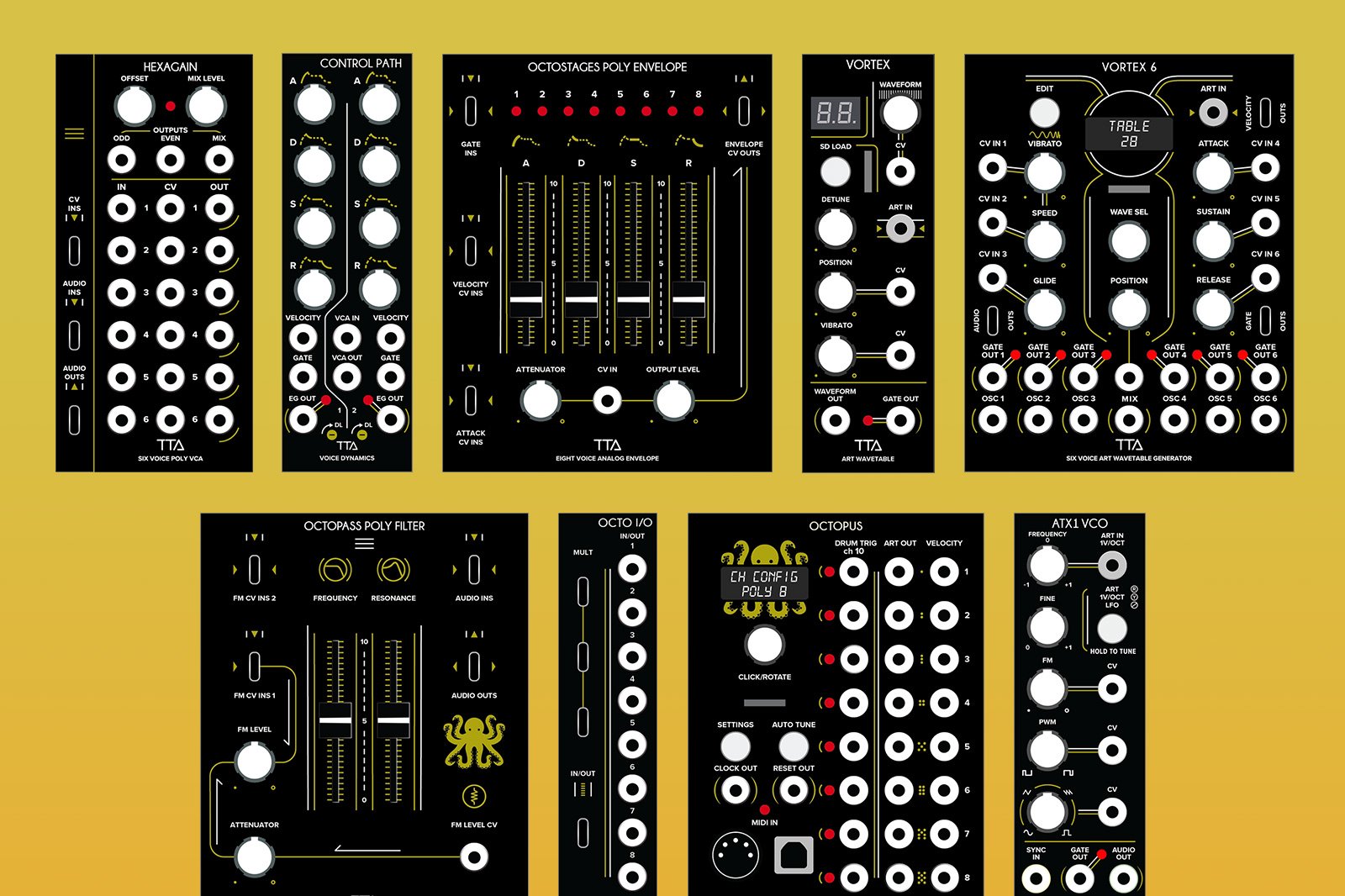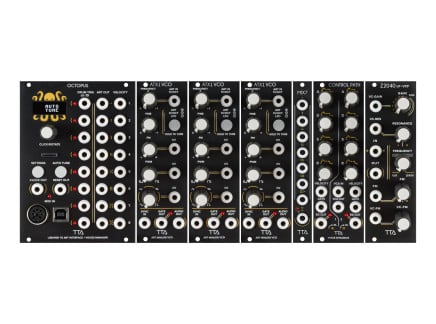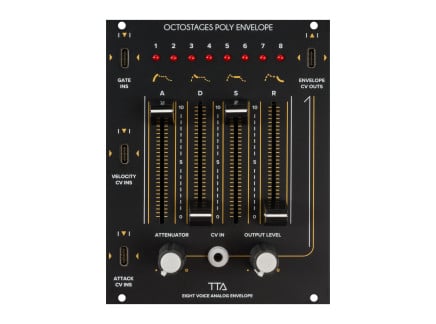Tiptop Audio has been making waves for the past couple of years with their line of Buchla designs in Eurorack format. But since unveiling ART at Superbooth 2023, Tiptop is proving that they're not only bringing the past into the present, but they're also thinking ahead and boldly stepping into the future of modular synthesis.
In case you missed the news, Tiptop has revealed a new line of ART Eurorack modules boasting incredible tuning precision and, perhaps to the interest of most, true polyphonic patching capabilities. Between the new ART communication protocol and their new Polytip format of patch cables, there are a ton of new ideas being revealed that challenge the conventional norms of modular synthesis.
In this article, we'll give some background as to what ART is all about and the challenges that it aims to solve, as well as provide an overview of the new modules. As you'll come to find out, ART was designed to be as elegant and streamlined as possible, while still open-ended enough to maintain the spirit of modular synthesis.
The Challenges of Tuning Modular Synthesizers
Tuning is an important process for any instrument, and given the vast sonic range and capability of a modular synthesizer, tuning may be one of the few common threads between otherwise completely different elements in a patch. For the solo performer, improviser, or anyone who simply records their patches down to a single stereo track, this process is usually fairly straightforward: tune all your oscillators and voices to be in tune with each other, and that's it! Of course, this process can become more elaborate in exceptionally large systems and/or those with unquantized analog sequencers, but tools like MIDI-CV converters and pitch quantizers can help.
However, when it comes time to jam with a friend, incorporate non-modular gear, or even just lay down overdubs on a previous recording, the difficulties of modular tuning become a bit more clear. Even with quantizers and other digital pitch modules, you will still need to make sure that your oscillator's base frequency is in tune with the instruments you're working with. Unlike MIDI, voltage is completely relative as a base for pitch—1V could be A440 or it could be middle C, all depending on how the oscillator is tuned.
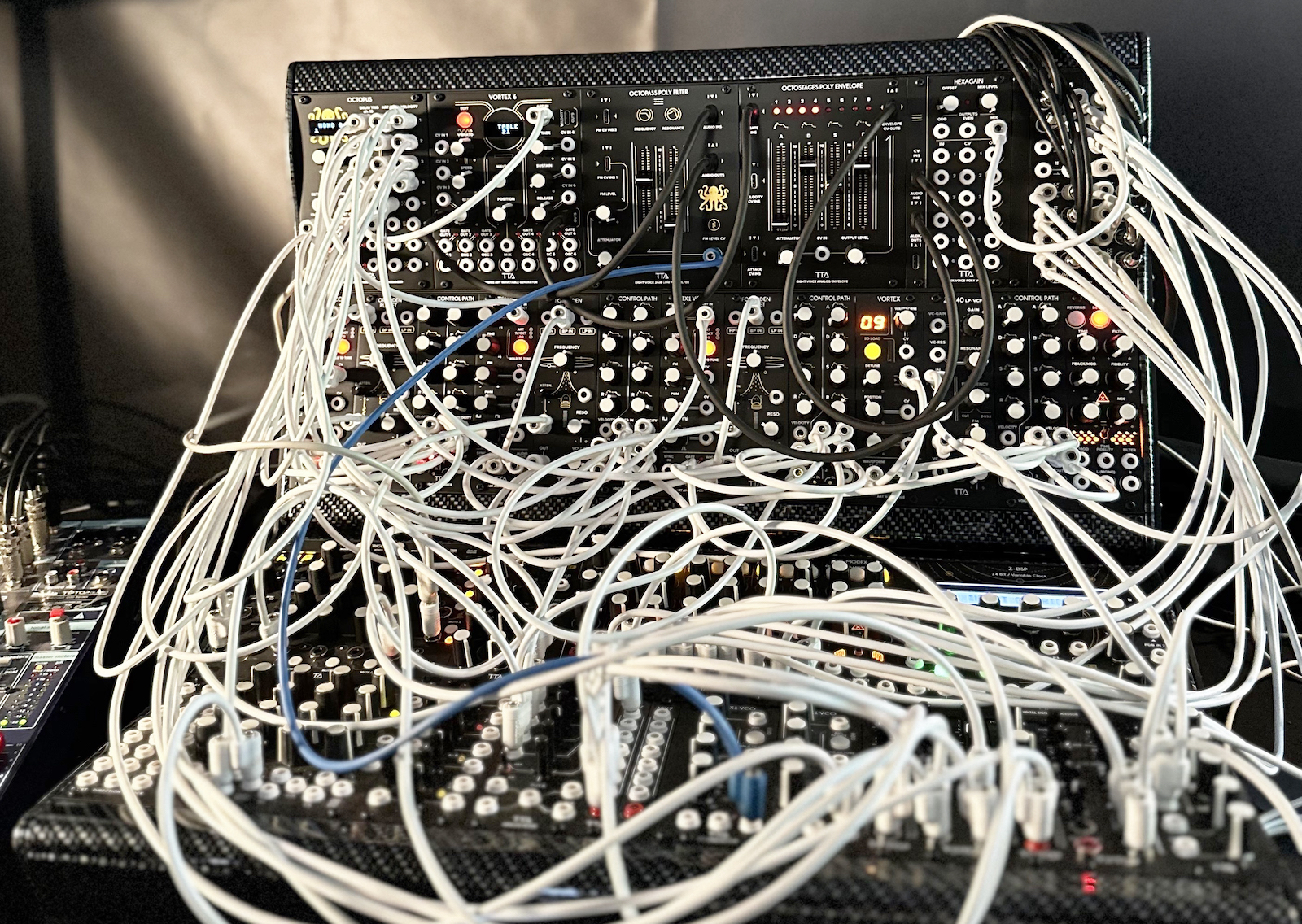
Being conscious of your oscillator's tuning is an easy habit to get into, but that's only one potential concern. Certain modules might only track well within certain note ranges and thus will begin to deviate from being "in tune" when pushed beyond that range. Temperature drift can also be a real concern, where tuning an analog oscillator again at a later point after setting up might be necessary. Furthermore, recalling a previous patch and dialing in the tuning again can be a real hassle, and frustrating when, despite your best efforts, the new layers are not in tune with the prior recordings.
The Challenges of Polyphonic Modular Patches
We've talked about creating polyphonic modular synthesizer patches a couple of times in the past, both in using traditional methods and contemporary solutions. It's not impossible, but the amount of work and planning involved is certainly much more than just pulling out a dedicated polysynth. That said, the creative possibilities are well worth the effort for some, though there are definitely some concerns worth keeping in mind, regardless of your chosen approach.
On one hand, true polyphonic patches are often prohibitively expansive and expensive. For even a simple eight-voice subtractive synth, you'll need eight oscillators, eight filters, eight VCAs, and eight times as many LFOs and envelope generators are desired. There's also the problem of voice allocation, usually requiring a system of switches or shift registers, and all of those potential tuning issues mentioned above are multiplied for all of your voices. This can be physically and financially overwhelming, and despite the appeal of a modular synthesizer's patchability, the practicality of a hardwired keyboard synth is clear.
On the other hand, modern options reduce the size and complexity of patches required for polyphony, but these conveniences come along with compromises. Macro chord-type oscillators are very fun for pads and can be flexible with their array of chord types and voicings, but they're not the best choice if you're aiming to recreate the seamless, weaving voice-leading techniques of orchestras. Additionally, these and other approaches using samplers and physical modeling voices usually lead to consolidated signal paths that share filters, envelopes, and other elements. While we love a good paraphonic patch, it's not the same as true polyphonic control.
Ideally, a solution that consolidates the size and amount of patching for polyphony would be perfect. And if there was also a way to remove the concerns of tuning and voice allocation, polyphonic modular systems would be way more streamlined, allowing the user to focus more on the fun aspects of patching. As it turns out, Tiptop Audio's new ART system manages to make it all possible in a way that's easier than ever before.
ART: An Ecosystem for Stable Tuning And Polyphony
Tiptop Audio began ART development as a solution to the tuning woes of Eurorack modular synthesizers. But it also ended up being perfectly suited to the creation of polyphonic patching systems, too. Tiptop has long had polyphonic Eurorack systems on their mind, even showing a prototype oscillator concept with multi-core patch cables over ten years ago at NAMM 2012. Things have come a long way since then, with the introduction of the ART protocol and the Polytip patching format serving as the catalyst for an all-new line of Tiptop modules.
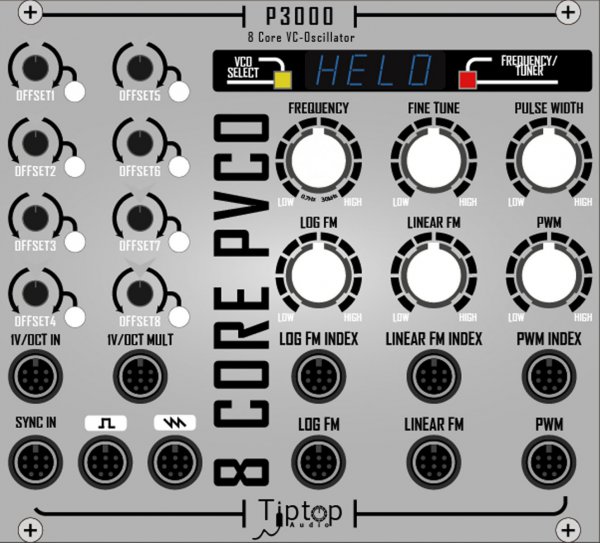 Tiptop Audio's P3000 prototype shown at NAMM 2012
Tiptop Audio's P3000 prototype shown at NAMM 2012
So, what is ART? Like MIDI, ART is a digital protocol for note data including note on/off, velocity, pitch bend, and more, but the rate of transmission is over 40 times faster than MIDI. ART also features a streamlined method of configuration compared to MIDI, with all channel setup and allocation handled internally by ART control modules and compatible oscillators. And since ART messages are absolute pitch references, just like MIDI, tuning is always consistent.
ART messages are sent over standard Eurorack patch cables, so they're as easily patched and distributed as 1V/Oct and other modular signals—fully compatible with passive multiples and stackable patch cables. But it's important to mention that ART is very much not the same thing as analog 1V/oct signals, and trying to use ART signals on incompatible oscillators won't yield usable results. As such, getting started with ART requires both compatible oscillators or voices as well as dedicated ART controllers.
An Overview of the First ART Modules
Tiptop Audio has now released the first batch of ART modules, offering a number of different ways to get your feet wet with ART. The ART protocol was designed to achieve a balance of simplicity and flexibility, and as such there are a couple of different ways to introduce ART into your modular system. More modules are in the works, but this initial group establishes the basic conventions of ART systems: a central ART controller coordinating a number of discrete polyphonic voices in the traditional modular sense with unprecedented precision in pitch control.
Let's begin with OCTOPUS, the first of Tiptop's ART controllers. At first glance, this looks like a regular MIDI-CV converter, but rather than producing 1V/Oct voltages, it translates MIDI data into ART messages along with velocity control voltage. OCTOPUS provides a number of configuration modes that group its eight channels into any combination of polyphonic or multi-mono settings. In Poly configurations, messages will rotate between different channels to work with individual monophonic voices, combining them into a polyphonic unit. Otherwise, ART channels correspond to MIDI channel numbers, so connecting MIDI sequencers, controllers, or DAWs allows you to easily control connected elements.
Complementary to OCTOPUS, Tiptop also offers their ART Quad Quantizer. This module pairs with your existing sequencers, LFOs, random voltage generators, and other CV sources to translate their signals into ART messages. Of course, you're able to quantize channels to any of the major scale's seven modes, and channel four offers special polyphonic capabilities to be used with forthcoming ART modules. But the key point of this module is that you don't have to give up your favorite sequencers or patching tricks in order to incorporate ART into your modular synthesizer.
To build discrete polyphonic voices in the traditional modular way, Tiptop currently offers two different ART-compatible oscillators: ATX1 and VORTEX. ATX1, a solid analog oscillator, is a shining example of how ART can eliminate the difficulties of tuning. When connected to OCTOPUS, ATX1 is able to analyze the environment of your modular case, accounting for temperature and heat to maintain stable tuning. Of course, it's still very patchable, supporting FM and hard sync, and Tiptop designed ATX1 to still exhibit enough of that "analog" feeling to not feel sterile.
VORTEX, on the other hand, is a digital wavetable oscillator with ART support. Like ATX1, it's a single, discrete voice that can be combined into polyphonic units with other ART modules. VORTEX features vintage digital-analog converters for a legacy-flavored sound, and it comes pre-loaded with numerous wavetables, but an SD card slot supports user waves to be loaded. Of course, you can select and modulate the position of the wavetable either manually or with control voltages.
A point worth mentioning here is that you won't find gate outputs for note events on OCTOPUS—instead, Tiptop has placed these on the oscillators themselves! We don't usually think of oscillators as the source of gates or triggers, but the implementation of ART makes this the most sensible place for voice gates to be found. This allows for the components of voices to be placed closer together in a rack and thus patched within themselves, rather than stretching cables all over your case. And as we'll soon see on the more complex ART modules, this is going to be really helpful for keeping things tidy.
In the context of subtractive synthesis, completing a full voice traditionally requires two envelope generators. One usually controls the filter, while the other is an amplitude manager connected to a VCA. To facilitate this arrangement in a compact package, Tiptop's Control Path contains all of these (except for the filter itself). The incorporated VCA is controlled by the right ADSR envelope, while the left may be patched out to a voice's filter or even something like the VORTEX wavetable position. In any case, both envelopes may also receive Velocity CV input for level control—in the case of ART systems, this would probably come from OCTOPUS, but no one is stopping you from sourcing that signal elsewhere!
Patching With ART
As we've seen so far, Tiptop Audio is providing everything you need to grab a handful of oscillators, Control Paths, and other processors like filters or even wavefolders to build discrete voices. But perhaps you're wondering what an ART system might look like—what Eurorack modules do you need to get started with ART?
For this initial launch, Tiptop is offering a couple of limited-time starter bundles that make it easy to dive right into patching with ART. Respectively centering around the ART Quad Quantizer and OCTOPUS modules, the bundles aim to approach ART interfacing in a way that makes the most sense for your workflow. And as an incentive to get in early, the bundles are priced a fair bit lower than if you bought all the included modules individually!
The Analog Bundle S1 features the ART Quad Quantizer, letting you easily patch in your favorite sequencers and CV sources for precision polyphonic control. Alternatively, The Analog Bunde S2 is the prime choice for DAW-based producers or MIDI controller players looking to incorporate modular polyphony into their music. Of course, this bundle also integrates nicely with drum synthesis rigs thanks to the Drum Trigger outputs mapped to MIDI channel 10.
Common between both of these bundles, three ATX1 oscillators are available to let you get a taste of ART's power. There's also a MIX7 on hand to sum your oscillators together, along with a Z2040 and Control Path module for filtering, enveloping, and VCA-ing. Yes, if you want to speak technically these bundles facilitate paraphonic patching rather than true polyphony, but the potential of ART is clear and it's easy to extend the systems from there!
Suggested ART Systems
The launch bundles are certainly a great way to get acclimated to the ways that ART can shake up your patching flow. But the possibilities don't stop there, and we've also got a few suggestions on how you could build up your own entirely custom ART rig. For the purposes of this article, we'll be showing off some suggested systems consisting entirely of Tiptop Audio modules, but of course, in the true spirit of Eurorack modular synthesis, you are welcome to build on these ideas with your personal favorite modules!
Buchla 200t Meets Wavetable
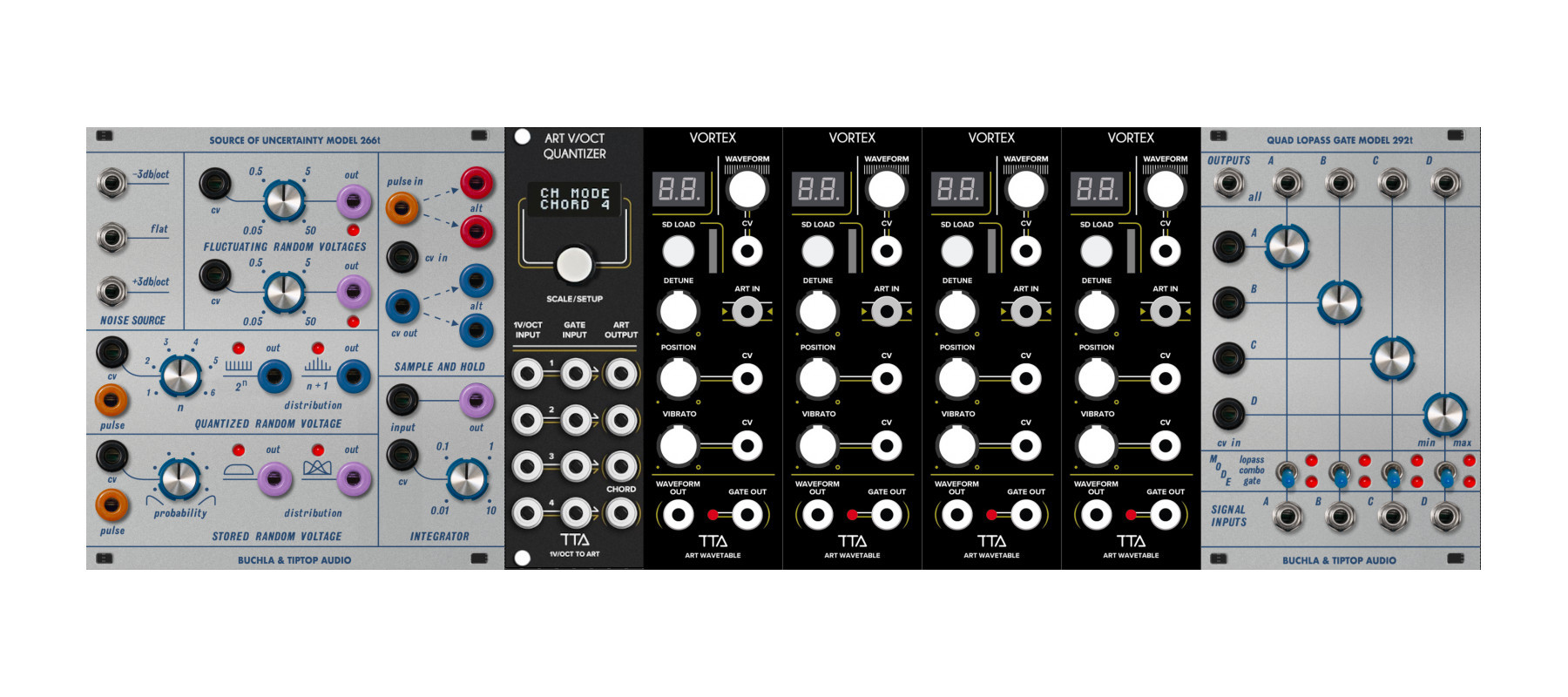
In our opinion, one of the best aspects of the Eurorack format is the ability to combine elements of otherwise completely distinct synthesis methods and techniques. That philosophy is on full display in this suggested ART system, combining a couple of Tiptop's Buchla modules with a handful of VORTEX wavetable oscillators. With the Model 266t Source of Uncertainty as a flexible voltage source, its many outputs may be combined and tamed with the ART Quad Quantizer. Each of the four VORTEX modules may then be patched into their own channel of the Model 292t Quad Lopass Gate, offering you a distinct wavetable-y twist on the classic "Buchla Bongo" patch.
Want a more classic Buchla sound? We'd be remiss not to mention that Tiptop Audio + Buchla's Model 259t, the Eurorack recreation of the module that solidified the complex oscillator archetype, features ART capabilities in addition to traditional 1V/Oct control. We're certain that we'll see more ART options for the Tiptop Buchla ecosystem in the near future.
Filters? How About Folders Instead?
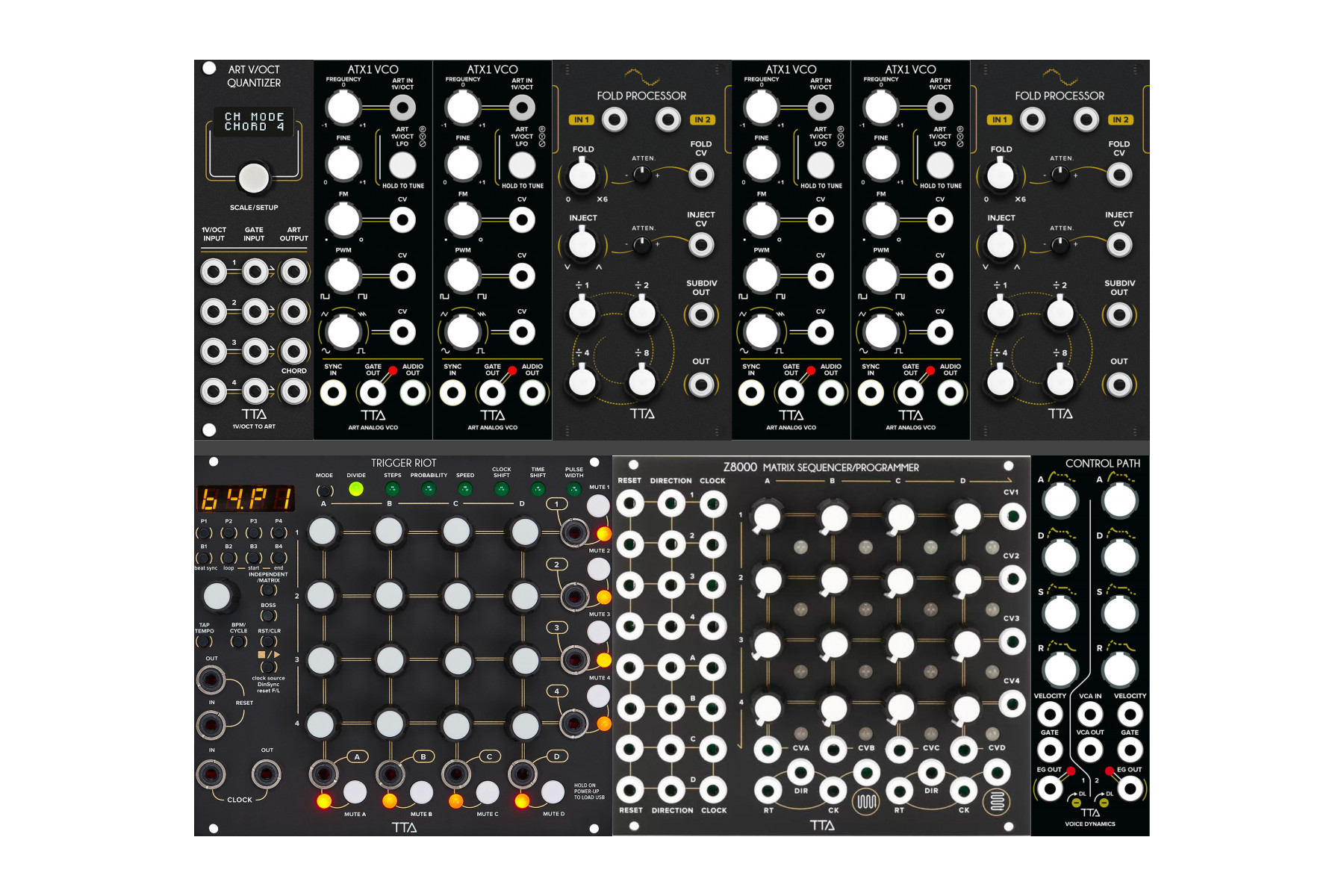
The ART Quad Quantizer appears again in this larger setup, this time offering a different flavor of West Coast synthesis. Rather than using filters such as the Z2040, we've instead paired the ATX1 oscillators with Tiptop's Fold Processor. This yields some surprisingly potent Serge-style results—the variable waveshape output of the ATX1 harkens back to the classic Serge NTO, while the Fold Processor is a Tiptop twist on the Wave Multipliers.
Further leaning into Serge territory, we've also included the Trigger Riot and Z8000 sequencers, which respectively offer modern rhythmic and variable voltage spins on Programmer-style sequencing and patching. Both of these modules feature an abundance of outputs, so they should pair nicely with the Quantizer's CV and Gate inputs for complex patching. The system also features a Control Path module for a couple of ADSR envelopes and a utility VCA—all of which can easily be utilized by leftover sequencer outputs.
Patching opportunities are a bit more open-ended with this particular setup. While you could certainly make use of all four Quantizer channels, we think this rig could also be interesting in duophonic applications—try using a couple of the ATX1s in LFO mode to modulate the other ATX1s or their respective Fold Processor. You could also create your own complex oscillators, or sum both ATX1s in the Fold Processor's dual inputs for incredibly rich harmonic generation.
Powerhouse Poly Plus Percussion
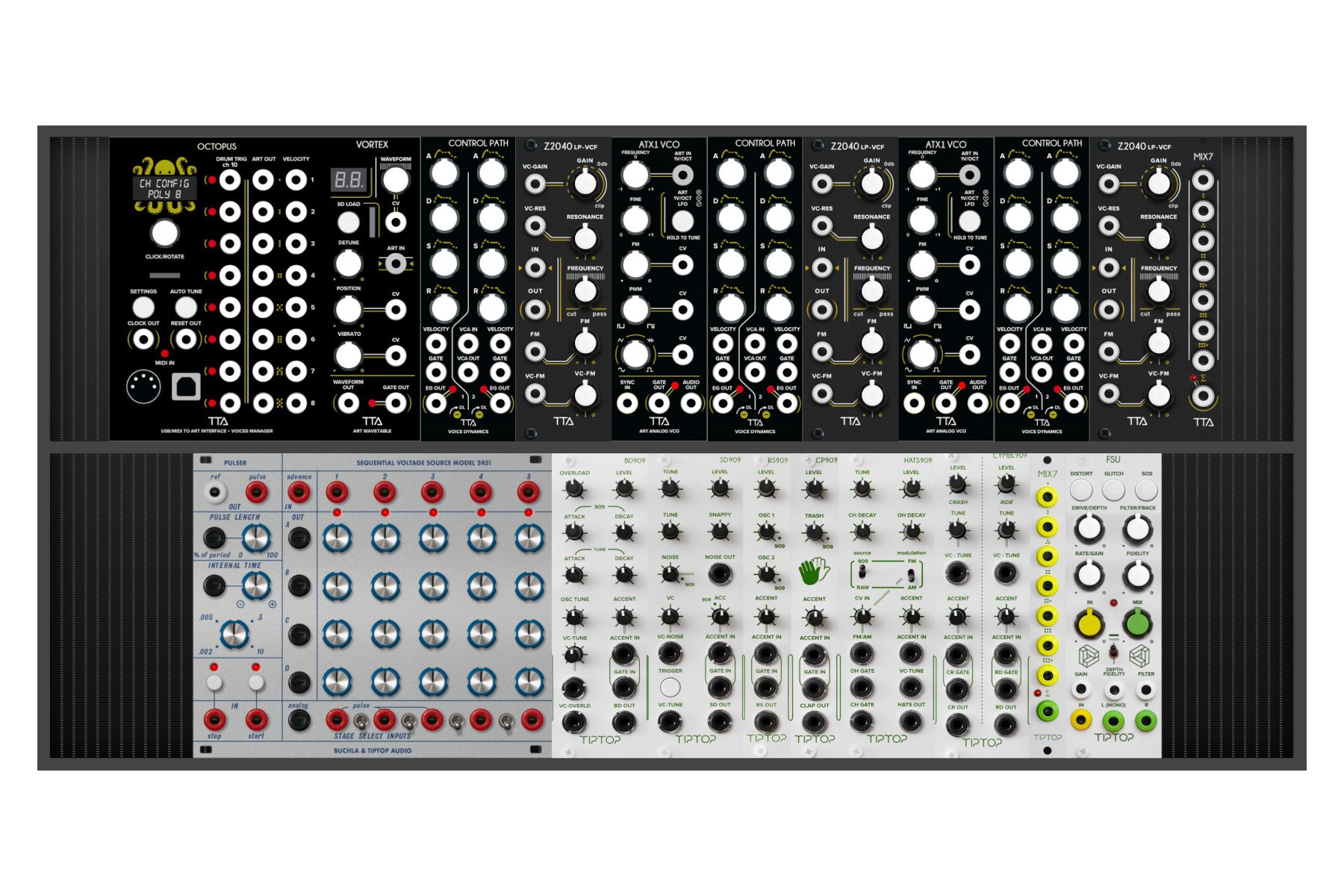
Here's the biggest ART system that we'll offer for your consideration today. Three full polyphonic voices built from a VORTEX and two ATX1 modules, all fitted out with their own Z2040 and Control Path modules. OCTOPUS is at the helm here, and we've included a set of Tiptop's 909 modules to make use of those Drum Trigger outputs. This setup can pair excellently with your DAW or a desktop device like a Digitakt or Beatstep Pro, and the added Model 245t Sequential Voltage Source and FSU effects module give you some more options to make things interesting.
Of course, if the constraints of money are no object, you could go even bigger—ART systems could be extended up to four or eight-voice rigs and beyond! But even with the considerations for patching and voice management established by these initial ART modules, remember how we stated earlier that building eight full voices can be a sizable endeavor. For example, an eight-voice, modular Minimoog-style instrument might require upwards of 50-60 individual modules. If using the bundles as a model, three ATX1s, a MIX7, a Z2040, and a Control Path is six modules per voice, giving a total of 48 modules before even considering an ART controller or others you'd want to include such as an output module or an effects processor. Uniformity comes at a cost (literally).
We'd never stop you from pursuing your deepest modular desires, but perhaps a better approach is on the horizon. For the space and budget-conscious patchers with polyphonic dreams out there, Tiptop Audio is preparing a solution for you in future modules that will seamlessly work with ART's capabilities: Polytip.
Polytip: A Polyphonic Module Patching Format
That's not a USB port on your module, that's Polytip! Well, technically it is a USB-C connector, but Polytip is a different specification: it's a compact, multi-core cable designed by Tiptop Audio for polyphonic patching. The choice of USB-C as the connector comes from their universal availability, and given recent tech mandates in the European Union this was a long-term consideration as well.
[Above: Tiptop Audio's Polytip modules on display at Superbooth 2023]
The first wave of Polytip-equipped modules made its debut in late Feburary 2025, showcasing both the power and future potential of patching multiple discrete signals on one cable. These new modules include the ART-compatible VORTEX 6 oscillator, the OCTOPASS eight-voice lowpass filter, the OCTOSTAGES eight-voice ADSR envelope, the OCTOGAIN eight-voice VCA, and the bidirectional OCTO I/O breakout adapter. These are all true polyphonic modules, but Polytip greatly reduces the number of cables required for patching.
Hang on—how does ART work in polyphonic contexts? Just like MIDI, ART messages are just data, and it's up to the receiving module to interpret and handle it. If you've ever tried playing chords on a keyboard monosynth, you'll know that you won't get chords out of it, no matter how hard you try. Instead, there's some note priority at play—usually playing the most recently received note. For monophonic ART modules like ATX1, the exact same result will occur, which is why OCTOPUS supports channel groupings. But for polyphonic ART modules like VORTEX 6, there's an internal voice allocator which distributes notes accordingly. That's why, even for VORTEX 6, you only need a single, standard patch cable for ART.
More than just an expanded VORTEX, VORTEX 6 is described as a PPG Wave 2.2-inspired polyphonic oscillator. This module has the unique distinction of featuring an ART input, as well as both discrete 3.5mm patch points and Polytip connections for its voice audio and per-voice gate outputs. This means that you can easily use your favorite existing collection of modules with its polyphonic capabilities, but the option to get into Polytip is always there.
To make complete polyphonic voices with Polytip patching, you can utilize the OCTOPASS, OCTOSTAGES, and OCTOGAIN modules. As you would find on a keyboard polysynth, these modules feature global controls that affect all voices, but there's still the ability to route audio and control signals independently via Polytip connections. OCTOPASS is eight 2044-style lowpass filters packed into one module, OCTOSTAGES is eight ADSR envelopes with velocity control, and OCTOGAIN is an eight-channel VCA that supports simultaneous use of Polytip and 3.5mm patching.
Polyphonic patching deserves utilities too! Octovert is a convenient attenuverter, giving you a manual bipolar Offset control for eight signals passing through, as well as a CV-controllable attenuator that works in both positive and negative domains. There's also a handy On-Off switch to remove it from your patch. And if you need to route Polytip signals to many destinations, the M Polytip multiple makes this a breeze.
Of course, there are plenty of situations where you might want to get signals in and out of the Polytip format. Bringing multi-channel control voltage modulation sources into Polytip can be incredibly valuable, as well as breaking out Polytip audio signals for further processing through effects or external mixing. This is where the OCTO I/O adapter comes in handy, supporting bidirectional conversion between 3.5mm and Polytip formats.
The Joy of Patching
This is only the beginning for ART and Polytip—Tiptop Audio is already mentioning that other ideas and concepts are in the work. Even just in this initial collection of modules, we think that the potential for really interesting polyphonic systems is clear, and it's likely a dream come true for anyone with polyphonic patching on their mind.
We're curious to see the other ART and Polytip modules that Tiptop has in development, and we especially hope to see these formats adopted by other Eurorack designers. In fact, the first 3rd party ART module was debuted at Superbooth 2024—an ART expander for XOR Electronics' NerdSEQ. After all, Eurorack became the thriving hub of ideas and cutting-edge designs that it is today thanks to the collective work of so many different minds—introducing ART and Polytip into this sphere is sure to be yet another way to create some really interesting things.

